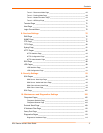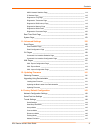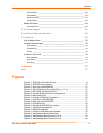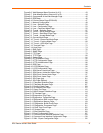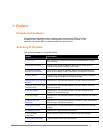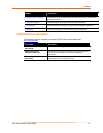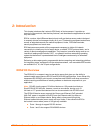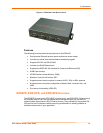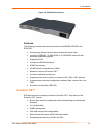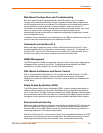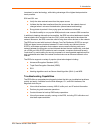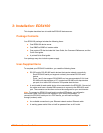
EDS Device Servers User Guide 13
2: Introduction
This chapter introduces the Lantronix EDS family of device servers. It provides an
overview of the products, lists their key features, and describes the applications for which
they are suited.
EDS is a unique, hybrid Ethernet terminal and multi-port device server product designed
to remotely access and manage virtually all of your IT/networking equipment and servers,
as well as edge devices such as medical equipment, kiosks, POS/retail terminals,
security equipment and much more.
EDS device servers contain all the components necessary to deliver full network
connectivity to virtually any kind of serial device, a reliable TCP/IP protocol stack, and a
variety of remote management capabilities. They boast an innovative design and run on
Lantronix’s leading-edge Evolution OS™, our powerful real-time networking operating
system that delivers an unprecedented level of intelligence and security to networked
equipment.
Delivering a data center-grade, programmable device computing and networking platform
for integrating “edge” equipment into the enterprise network, rack-mountable EDS models
are available in 8, 16, and 32 port configurations.
EDS4100 Overview
The EDS4100 is a compact, easy-to-use device server that gives you the ability to
network-enable asynchronous RS-232 and RS-422/485 serial devices. It can deliver fully
transparent RS-232/422 point-to-point connections and RS-485 multi-drop connections
without requiring modifications to existing software or hardware components in your
application.
Note: RS-485 circuits support 32 full-load devices or 128 quarter-load devices.
Each EDS4100 RS-485 port, however, counts as one device, leaving up to 31
full-load or 127 quarter-load devices that can be connected to the RS-485 circuit.
The EDS4100 device server supports the Power-over-Ethernet (PoE) standard.
With PoE, power is supplied to the EDS over the Ethernet cable, by either an
Ethernet switch or a midspan device. Being able to draw power through the
Ethernet cable eliminates power supply and cord clutter. It also allows the EDS to
be located in areas where power is not typically available.
Ports 1 through 4 support RS-232 devices.
Ports 1 and 3 also support RS-422/485 devices.



